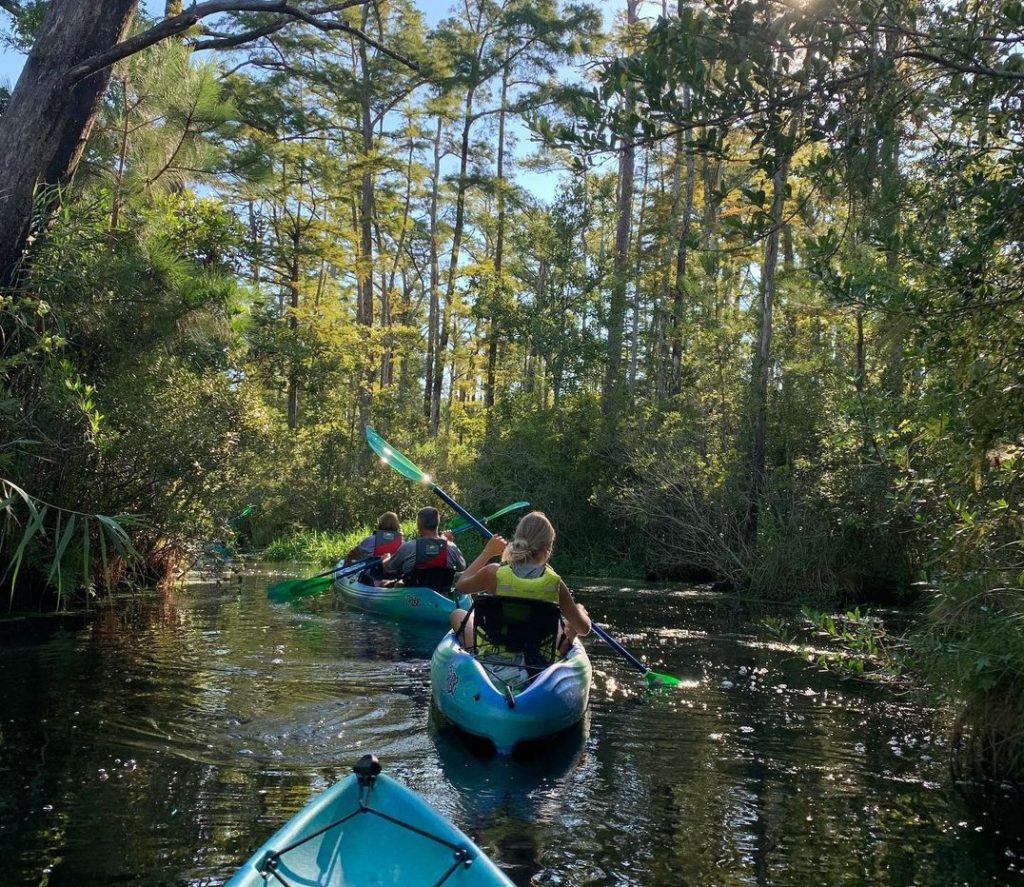Alligator River National Wildlife Refuge
In conclusion, the Alligator River National Wildlife Refuge is a great place to experience the wildlife and nature of North Carolina. There are many different trails that you can explore, and there is also a visitor center where you can learn more about the refuge and the wildlife that lives here.
If you’re looking for a place to enjoy the outdoors and see some of North Carolina’s amazing wildlife, then be sure to check out the Alligator River National Wildlife Refuge.
North Carolina is a beautiful state with plenty of coastline to explore on the East Coast. Many people know the state for its Outer Banks, but there is so much more to see! Just a little way inland from the coast is the Alligator River National Wildlife Refuge.
Come visit the Alligator River National Wildlife Refuge on the Albemarle Peninsula in eastern North Carolina. The Alligator River National Wildlife Refuge is located in the northeastern part of the state and is home to a variety of plant and animal species. The refuge is also a great place to enjoy the outdoors with plenty of opportunities for hiking, fishing, and bird watching.
There are over 154,000 wildlife acres of wetland habitats to venture into, observe, and photograph. There are over 200 species of migratory birds including white swans, geese, and more.
It is easy to get here from Raleigh, North Carolina. A three-hour drive from the city and start a day trip that will give you plenty of time to explore the refuge and see all that it has to offer.
If you are planning a vacation to the Outer Banks, North Carolina, you will be pleased to know the refuge is only 45 minutes away from Nags Head and a little less than an hour from Kill Devil Hills.
It is a 152,000-acre plot of land on North Carolina’s coast that was once called “No Man’s Land” due to its collection of marshy islands, large alligators, and mosquitoes that locals mostly avoided. The area was set aside in 1984 to protect the habitat of several animal species such as the red wolf, one of the most endangered animals in the world.
Wildlife Species at the Refuge
The vast protected area supports large populations of black bear, and is one of the best places to see these animals in the wild. The best time to see them is in the morning.
Come see wildlife diversity such as wintering waterfowl, river otters, wood ducks, shorebirds, American woodcock, wading birds, raptors, alligators, white-tailed deer, cottontail rabbits, and more.
The refuge is also home to the very endangered red wolf, one of the most endangered animals in the world.
More than 50 species of fish live in the refuge’s waters, including bass, catfish, and perch.
Plants At The Refuge
There are several plant species to observe at the refuge. Visitors can see the bald cypress, Atlantic white cedar, wildflowers, and shrubs are abundant.
The Alligator River National Wildlife Refuge is a great place to enjoy the outdoors and learn about the wildlife and plants that call this place home.
What Does The Refuge Do?
The amazing refuge was established in 1984 to protect various rare wildlife species. The U.S. Fish and Wildlife Service manages the refuge. Its objective is to conserve and protect the endangered red wolf, red-cockaded woodpeckers, American alligators, and more through reintroduction, public education, law enforcement, and habitat management.
There are five goals of the refuge:
- To provide habitat and protection for various endangered and other wildlife species
- To conserves and restore wetlands
- To provide opportunities for compatible wildlife-related recreation and environmental education
- To conduct research that will contribute to the management of refuge resources
- To protect and enhance water quality
The Pocosin wetlands, located within the refuge, are some of the most diverse and unspoiled ecosystems in North America. They provide habitat for a variety of plants and animals, including the endangered red wolf.
The refuge is also home to the largest population of black bears on the East Coast.
Activities at The Refuge

Great place to get an outdoor education in wildlife habitats and activities, wetlands, as well as the interdependence between animals and plants.
Kayaking is a great way to spot water-based animals such as river otters and waterfowls. There are canoe and kayak rentals available at the visitor center.
Hiking through the refuge is a great way to see land-based animals such as deer, rabbits, and snakes.The refuge has 22 miles of hiking trails. Fishing is allowed in some areas of the refuge.
A guided tour is a good option to learn about the refuge. Consider taking the Kitty Hawk Maritime Forest Kayak Tour.
Trails at The Refuge

The longest trail is the 22-mile long Goose Creek Trail which is great for hiking, biking, and horseback riding.
There are also shorter trails such as:
- The 0.5-mile long Deer Run Trail
- The 1-mile long Milltail Creek Trail
- The 1.3-mile long Perimeter Trail
- The 2.3-mile long Creek Cutoff Trail
Creef Cut Wildlife Trail is a great place to see alligators, otters, and beavers.
The Milltail Creek Wilderness Area is perfect for bird watching enthusiasts.
What is the Best Time to Visit Alligator River National Wildlife Refuge?
The best time to visit the Alligator River National Wildlife Refuge is in the fall or spring when the temperatures are cooler.
Summer can be very hot and humid, and in the winter the refuge can be inaccessible due to flooding. If you plan to come during these two seasons, make sure you check the weather reports ahead of time.
What to Pack
When visiting Alligator River NWR, it is important to pack for the weather and activities you plan on doing.
- If kayaking, bring a life jacket, sunscreen, insect repellent, hat, snacks, and water.
- For hiking, bring comfortable shoes, sunscreen, insect repellent, hat, snacks, and water.
- Bird-watching enthusiasts should bring binoculars and a bird guide. You have over 200 species of birds to look for!
Don’t forget your camera to capture all the memories of your visit to Alligator River NWR.
Things to Do Nearby
While you have plenty of ways to stay occupied at the National Wildlife Refuge, a trip to North Carolina wouldn’t be complete without venturing out and enjoying all that this beautiful area has to offer.
There are many things to do in the Outer Banks area. Many people come to this region to enjoy the beaches, fishing, and boating.

The Wright Brothers National Memorial is a popular tourist destination. This spot commemorates the first powered flight in history.

Jockey’s Ridge State Park is the perfect place to enjoy the outdoors. This park has sand dunes, picnic areas, and hiking trails.

The Roanoke Island Festival Park is a must-see for history buffs. This interactive park tells the story of the first English settlement in America.
No matter what interests you, there is something for everyone at and near the Alligator River National Wildlife Refuge.
How To Get To The Alligator River National Wildlife Refuge
The Alligator River National Wildlife Refuge is located in Dare County, North Carolina. The refuge is about a 45-minute drive from Nags Head, and a 1.5-hour drive from Elizabeth City. The best route to take is NC-64 East.
There is no public transportation to the refuge, so the best way to get there is by car.
Add the NWR To Your North Carolina Trip
Posted on 08/23/2022 in Things To Do


















